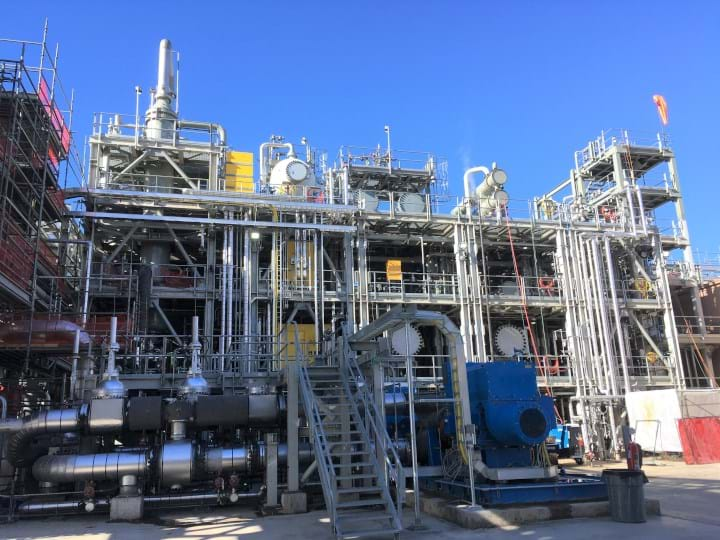Safer and more efficient alkylation process now at commercial scale

CHEVRON and Honeywell have started commercial operation of a new alkylation process using an ionic liquid catalyst that is safer and more efficient than traditional methods.
Alkylation combines light olefins such as butylene with isobutane to create a high-octane blending component that can be used to produce high-octane gasoline. The new alkylation process was developed by Chevron and licensed to Honeywell, and is branded ISOALKY. According to Honeywell, it is the first new successful liquid alkylation technology to be introduced in more than 75 years. The ISOALKY process was proven in the US at a demonstration unit at Chevron’s Salt Lake City refinery for five years. Work began on converting Chevron’s hydrofluoric acid (HF) alkylation unit in Salt Lake City to ISOALKY technology in 2017. The commercial-scale unit has now become operational.
Alkylation typically uses a catalyst such as sulfuric acid or HF to create high-octane gasoline. However, the use of HF has been associated with explosions at refineries. For example, a ruptured pipe in the alkylation unit at the Philadelphia Energy Solutions refinery in June 2019 released 2.3 t of highly toxic HF, which formed a vapour cloud before being ignited. The US Chemical Safety Board (CSB) has called for safety regulations to be updated around the use of HF.
ISOALKY uses an ionic liquid as the catalyst as opposed to sulfuric acid or HF. This catalyst has negligible vapour pressure so does not form a vapour cloud, which eliminates the need for catalyst-specific mitigation systems sometimes used for conventional technologies, according to Helin Cox, Business Director for Alkylation and Treating at Honeywell UOP. The catalyst is also less toxic and can be handled with standard refinery PPE compared to the acid-handling PPE required for the conventional process.
The process is also significantly more efficient. “At reaction conditions, the ISOALKY catalyst has orders-of-magnitude stronger acidity than traditional liquid acid catalysts, which fundamentally changes the volume of catalyst required for the reaction,” Cox told The Chemical Engineer. “The catalyst-to-hydrocarbon ratio in the reactor is 3–6%, compared to greater than 50% for traditional liquid alkylation technologies. The higher activity and ease of catalyst separation results in catalyst consumption that is 400 to 600 times lower than sulfuric alkylation. This eliminates the need for an expensive on-site acid regeneration plant or extensive acid storage and transportation requirements.”
It has greater flexibility with C3–C5 olefin feedstocks and can also directly process other feedstocks such as ethylene, which other technologies require to be converted to butene first.
There are also environmental benefits to ISOALKY, as it can also use byproducts that are treated as waste in the traditional method. Alkylation has an unwanted side reaction that creates what is known as a conjunct polymer, which can deactivate the catalyst. When a H2SO4 catalyst is regenerated, it emits SO2 and CO2 emissions, and if a HF catalyst is used then the conjunct polymer is incinerated. However, the catalyst regeneration process of ISOALKY is emissions-free and is regenerated on site. It has the added advantage of being able to convert any conjunct polymer to LPG and naphtha-range material.
Cox added: “With the ISOALKY process, carbon and hydrogen efficiency is maximised via product yield improvement, and the inconvenience, maintenance, environmental emissions, and costs associated with a separate catalyst regeneration plant are eliminated.”
Mike Coyle, President of Chevron Manufacturing, said: “The ISOALKY plant is an exciting achievement for Chevron and the Salt Lake Refinery, and it’s poised to be a game changer for the refining industry.”
Bryan Glover, President and CEO of Honeywell UOP, said: “ISOALKY is a groundbreaking new technology for refiners, and a lower-risk and economical solution compared to conventional liquid acid technologies that produce alkylate. Together with Chevron, Honeywell UOP has commercialised a solution that meets the rising global demand for cleaner-burning fuels at a lower cost while simplifying complex handling requirements.”
Recent Editions
Catch up on the latest news, views and jobs from The Chemical Engineer. Below are the four latest issues. View a wider selection of the archive from within the Magazine section of this site.




